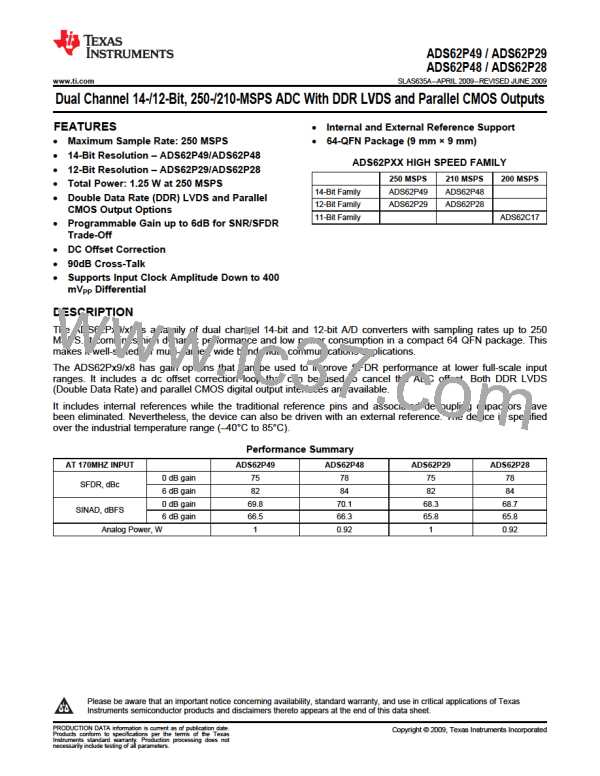ADS62P49 / ADS62P29
ADS62P48 / ADS62P28
www.ti.com............................................................................................................................................................. SLAS635A–APRIL 2009–REVISED JUNE 2009
DEFINITION OF SPECIFICATIONS
Analog Bandwidth – The analog input frequency at which the power of the fundamental is reduced by 3 dB with
respect to the low frequency value.
Aperture Delay – The delay in time between the rising edge of the input sampling clock and the actual time at
which the sampling occurs. This delay will be different across channels. The maximum variation is specified as
aperture delay variation (channel-channel).
Aperture Uncertainty (Jitter) – The sample-to-sample variation in aperture delay.
Clock Pulse Width/Duty Cycle – The duty cycle of a clock signal is the ratio of the time the clock signal remains
at a logic high (clock pulse width) to the period of the clock signal. Duty cycle is typically expressed as a
percentage. A perfect differential sine-wave clock results in a 50% duty cycle.
Maximum Conversion Rate – The maximum sampling rate at which certified operation is given. All parametric
testing is performed at this sampling rate unless otherwise noted.
Minimum Conversion Rate – The minimum sampling rate at which the ADC functions.
Differential Nonlinearity (DNL) – An ideal ADC exhibits code transitions at analog input values spaced exactly
1 LSB apart. The DNL is the deviation of any single step from this ideal value, measured in units of LSBs.
Integral Nonlinearity (INL) – The INL is the deviation of the ADC's transfer function from a best fit line
determined by a least squares curve fit of that transfer function, measured in units of LSBs.
Gain Error – Gain error is the deviation of the ADC's actual input full-scale range from its ideal value. The gain
error is given as a percentage of the ideal input full-scale range. Gain error has two components: error due to
reference inaccuracy and error due to the channel. Both these errors are specified independently as EGREF and
EGCHAN
To a first order approximation, the total gain error will be ETOTAL ~ EGREF + EGCHAN
For example, if ETOTAL = ±0.5%, the full-scale input varies from (1-0.5/100) x FSideal to (1 + 0.5/100) x FSideal
.
.
.
Offset Error – The offset error is the difference, given in number of LSBs, between the ADC's actual average
idle channel output code and the ideal average idle channel output code. This quantity is often mapped into mV.
Temperature Drift – The temperature drift coefficient (with respect to gain error and offset error) specifies the
change per degree Celsius of the parameter from TMIN to TMAX. It is calculated by dividing the maximum deviation
of the parameter across the TMIN to TMAX range by the difference TMAX–TMIN
.
Signal-to-Noise Ratio – SNR is the ratio of the power of the fundamental (PS) to the noise floor power (PN),
excluding the power at DC and the first nine harmonics.
PS
SNR = 10Log10
PN
(1)
SNR is either given in units of dBc (dB to carrier) when the absolute power of the fundamental is used as the
reference, or dBFS (dB to full scale) when the power of the fundamental is extrapolated to the converter’s
full-scale range.
Signal-to-Noise and Distortion (SINAD) – SINAD is the ratio of the power of the fundamental (PS) to the power
of all the other spectral components including noise (PN) and distortion (PD), but excluding dc.
PS
SINAD = 10Log10
PN + PD
(2)
SINAD is either given in units of dBc (dB to carrier) when the absolute power of the fundamental is used as the
reference, or dBFS (dB to full scale) when the power of the fundamental is extrapolated to the converter's
full-scale range.
Copyright © 2009, Texas Instruments Incorporated
Submit Documentation Feedback
67
Product Folder Link(s): ADS62P49 / ADS62P29 ADS62P48 / ADS62P28

 TI [ TEXAS INSTRUMENTS ]
TI [ TEXAS INSTRUMENTS ]